Wow, is it new year already? Holy macaroni! I didn't do half the stuff I promised to do for this blog T.T... But to my rescue, I had to read to tests each week and then there was the suffle with my old school. But I'm trying coach! xD
Well, here's my New Year Promise(s):
1. I solemly promise to do kitsuke once a week on Kitsuke Day (most likely Saturday/Sunday)
2. I solemly promise to do SOMETHING kimono/japan related each week besides kitsuke.
I'm very bad at keeping long term promises, but I hope I will keep these ones!
What's your New Year resolutions?
maanantai 31. joulukuuta 2012
tiistai 6. marraskuuta 2012
20s shoes!
Ever wanted a pair of 20s shoes to match your nice taisho style? Well, the American Duchess has put the preorder up for the 23Skidoo Spectator shoes! You can find them here: American Duchess Shop
Aren't they purdy? Aaaaand getting along with my habits, here's a little product information:
Enjoy!
 |
| 23Skidoo |
- Uppers are high grade, soft, hand-stitched calfskin (that will stretch slightly over time).
- Faux leather sole with excellent wear characteristics and suitable for dancing.
- Custom made French heels are 2 3/8 inches high, and perfectly balanced for all-day comfort.
- 23 Skidoo has been constructed on dance shoe lasts, and is meant to fit snuggly, as a dress shoe.
- "B" width (average).
- It runs true to size for most customers.
- Order a half-size larger for wide-width feet, if you prefer your shoes to fit more loosely, or intend to wear with thicker stockings.
Enjoy!
sunnuntai 28. lokakuuta 2012
In Our Town of Halloween
Halloween is officially on Wednesday, but we are working/in school then and scathered around the country, so we celebrated Halloween yesterday. It was great fun to see friends, since two of them I can only see once in a year, during our halloween party^^. The party itself is non-alchoholic, only fizzy drinks and water allowed, but you can have fun even without alchohol. Most of the group is teadrinkers in any case.
But well, here are some pictures of the kitsuke I wore:
First I thought of using a mofuku, but I was not sure about the appropriesness (is that even a word? It is now!) and the fact that I had to be cleaning and cooking before the party starts, so I settled on to one of my newest ones, a jinken komon with chrysanthemum pattern. While dressing I noticed something rather awesome: This kimono is perfectly my size! Except maybe around the bust, but that's something I should have noticed while dressing. My collars kept sliding up all evening.
Because these images are pre-party, I'm having my sleeves pulled up. I let them loose when the guests started to arrive.
I don't think I have never gotten a better profile. This must be because I went to have my spine snapped back into place on Friday. I had a wrong position of the hips, and in this picture my spine has been restored into place. It didn't hurt a bit, but I learned that I have loose joints in the hips, which had slipped into a bad position and caused my back to ache. But now they are back to normal and my back doesn't hurt.^^
Our two gentleman guests carved this pumpkin for us. They are no experts, but I think they made a good job.
But well, here are some pictures of the kitsuke I wore:
First I thought of using a mofuku, but I was not sure about the appropriesness (is that even a word? It is now!) and the fact that I had to be cleaning and cooking before the party starts, so I settled on to one of my newest ones, a jinken komon with chrysanthemum pattern. While dressing I noticed something rather awesome: This kimono is perfectly my size! Except maybe around the bust, but that's something I should have noticed while dressing. My collars kept sliding up all evening.
Because these images are pre-party, I'm having my sleeves pulled up. I let them loose when the guests started to arrive.
I don't think I have never gotten a better profile. This must be because I went to have my spine snapped back into place on Friday. I had a wrong position of the hips, and in this picture my spine has been restored into place. It didn't hurt a bit, but I learned that I have loose joints in the hips, which had slipped into a bad position and caused my back to ache. But now they are back to normal and my back doesn't hurt.^^
Our two gentleman guests carved this pumpkin for us. They are no experts, but I think they made a good job.
HAPPY HALLOWEEN EVERYBODY!
torstai 18. lokakuuta 2012
Kimono patterns: Dyed patterns
I've been putting this off for too long now, as I feel that my knowledge in this field is lacking, but I'm giving it a go in any case. Since I have now proclamed my lack of knowledge, please understand that mistakes are possible and if you know better than me, you are free to correct me. Thank you for understanding.
Bingata originates in the Okinawa and the Ryukyu Kingdom (c. 14th century). The term "bingata" does not appear in the old documents and it was called the katachichi (to apply patterns) or hana-nunu (flower cloth). The first person to call this fabric bingata was Iha Fuyu (1876-1947), which means that as a term, bingata is a rather new, but as a fabric dyeing technique, it is an old one.
Read more about bingata in jahitchcock.com
Edo komon became popular when Edo (modern day Tokyo) became the centre of komon production. Especially komon pattern made from small pinpoint dots. The pattern is made by forcing rice paste through a small stencil, making a pattern of small dots, and then dying the backgroung fabric. The rice paste keeps the pattern white while the rest of the fabric takes the dye. In early Edo period the colors for Edo komon were mainly indigo-white. About Edo Komon has a detailed information on the process on making an Edo komon kimono.
Shibori is the general term for several types of tie-dye dyeing. The fabric can be binded, stitched, folded, twisted, compressed or capped. Even I know that wikipedia is a bad place to use as information goes, but the shibori section does list a few shibori technique names and explanations. How reliable these are, I cannot say for sure, so read with causion.
Yuzen is a starch-resist dyeing technique invented by Miyazaki Yuzen during the Genrokuera (1688-1704) of Edo period. The technique uses glutinous rice as the resist, which allows the freestyle design. Yuzen has watercolor like patterns and harmoniously blending colors. The realistic touches on the pattern finishes the look. Short History of Yuzen Dyeing foundable here.
Hachijou is listed in the Book Of Kimono by Norio Yamaka as a yellow cloth first made in the Hachijou island near Tokyo. There are three kind of hachijou colors: bright yellow Kihachijou color is produced from a dye extracted from the kariyasu grass, the brown Tobihachijou comes from the madami plant and the black Kurohachijou dye comes from the bark of the chinquapin. Characteristic design for these kimono are stripes or checks, in either plain weave or twill.
Keiichi Takasawa lists these next terms in his book Kimono: A pictorial story of the kimono (1948):
Conserning general dyeing process:
Shinzen vat-dyeing in single color
Nassen print dyeing, using copper roller
Nukizome dyeing with colored paste
Hikizome dyeing with brush and stencilled papers
Surizome dyeing by rubbing over stencils
Sosogikomizome dyeing as in the popular tenugui towel
Kakizome designs hand painted with dyes by artists
Kukurizome tying with threads and dyeing
Kouketsuzome Another name for kukurizome
Suminagashi dyeing in the "grain of wood" pattern
Rouketsuzome dyeing with wax, like Javanese batik
Kirifukizome dyeing with sprayer
Tsutsuhiki dyeing with a paste tube
Kureonzome dyeing with crayons.
Conserning kimono patterning:
Soumoyo all over pattern
Susomoyo hem pattern
Uramoyo lining pattern
Semoyo back pattern
Yagasuri scattered arrow-shaped figures
Sharyou fretwork
Ichimatsu chequered
Sambenkoshi three bar fretwork
Dandara checkers
Asanoha hemp leaf
The kukurizome and the kouketsuzome seem to be some kind of shibori techniques. I had never heard some of these terms before I got these books and I do not know if they are still in use. I listed them here incase someone has come against there terms and wasn't sure what they meant. The book was published 1948 so some of these terms might not be in use anymore. I'm still doing research on these, so I'm sorry I cannot provide more information on these. They are fascinating thou.
Dyed patterns on a kimono
Ai-zome is indigo dyeing. The basic material for this dye comes from the leaf of the polygonym tinctorium plant. The japanese method to extract the dye is different than that in the world. Kosoen.com has a good explanation on how the dye is processed and made. Indigo dyes are mostly used in yukata. |
| Image from here |
Read more about bingata in jahitchcock.com
.jpg) |
| Image from here |
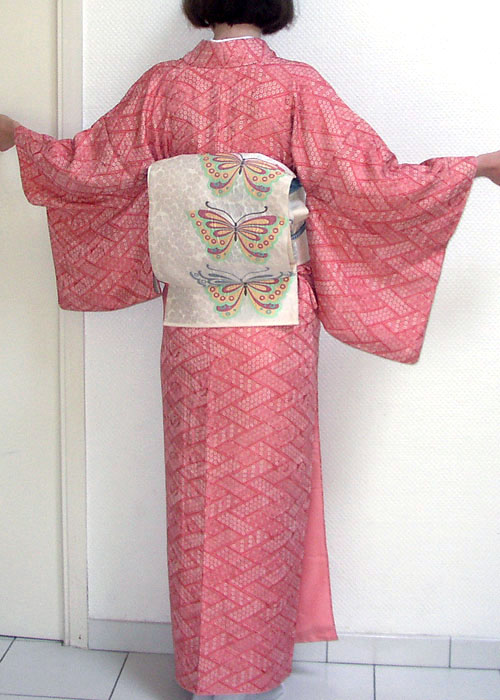 |
| Image by kimono.fraise.net |
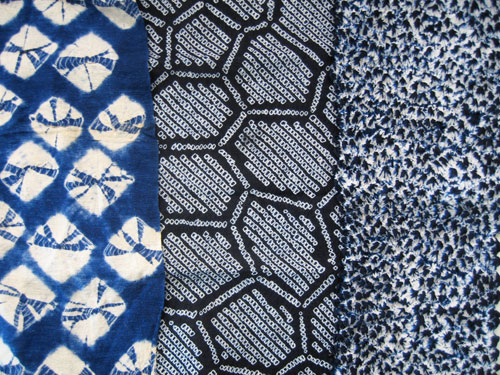 |
| Image from here |
 |
| Image from Here |
 |
| Image from here |
 |
| Kihachijou kimono from here |
 |
| Image from here |
Conserning general dyeing process:
Shinzen vat-dyeing in single color
Nassen print dyeing, using copper roller
Nukizome dyeing with colored paste
Hikizome dyeing with brush and stencilled papers
Surizome dyeing by rubbing over stencils
Sosogikomizome dyeing as in the popular tenugui towel
Kakizome designs hand painted with dyes by artists
Kukurizome tying with threads and dyeing
Kouketsuzome Another name for kukurizome
Suminagashi dyeing in the "grain of wood" pattern
Rouketsuzome dyeing with wax, like Javanese batik
Kirifukizome dyeing with sprayer
Tsutsuhiki dyeing with a paste tube
Kureonzome dyeing with crayons.
Conserning kimono patterning:
Soumoyo all over pattern
Susomoyo hem pattern
Uramoyo lining pattern
Semoyo back pattern
Yagasuri scattered arrow-shaped figures
Sharyou fretwork
Ichimatsu chequered
Sambenkoshi three bar fretwork
Dandara checkers
Asanoha hemp leaf
The kukurizome and the kouketsuzome seem to be some kind of shibori techniques. I had never heard some of these terms before I got these books and I do not know if they are still in use. I listed them here incase someone has come against there terms and wasn't sure what they meant. The book was published 1948 so some of these terms might not be in use anymore. I'm still doing research on these, so I'm sorry I cannot provide more information on these. They are fascinating thou.
It's time for a kitsuke
 |
| Kiki enjoying a pile of silk kimono items. |
Well, atleast more or less. Two of my latest kimono have not yet arrived and I've been trying to clean this appartment (with no much success). First one is a handmade kimono. The fabric I bought from the local Eurokangas fabric store. As you can see from the pattern, it's a komon, but I was short on everyday kimono, so it's perfect.
Next one is the purple-white tsumugi.
Aaaaand then I just had fun.
Then I remembered that I had a mofuku I had not found any use yet:
maanantai 8. lokakuuta 2012
New arrivals!
First of all, I am deeply sorry that I have not updated about the kimono patterning facts, I have been working very long days and our weekends have been booked solid, but in a few weeks I will be having an autumn break and then I have time to catch up on everything.
But here's my new babies on their way home!
I only had 1 komon kimono before these three, so now I have more everyday wear. Too bad I have to wait for a week before I can wear these pretties. During work days it's impossible for me to wear a kimono. But only a week and then it's kimono time! Wait for the pictures!
Images from:
1.&2. kimonopetitjapon's eBay auction
3. japanese.antiques eBay auction
But here's my new babies on their way home!
 |
| Black chrysanthemum jinken kimono. |
 |
| Brown lattice jinken kimono. |
 |
| Purple-white checkered tsumugi kimono. |
Images from:
1.&2. kimonopetitjapon's eBay auction
3. japanese.antiques eBay auction
sunnuntai 23. syyskuuta 2012
Pictures of the mystery kurotomesode
Hallo! Today I got around on taking pictures of the kurotomesode I got in the mail last week. I got to study it closer now and noticed that the false layers on the collar and the hem had been removed rather forcibly, tearing the lining fabric and causing a tear on the neck of the kimono. These are luckily not visible to the front. The biggest mystery is the pattern on the right breast.
Sorry about the blurry images, some adjustment in the camera are missmatched...
I know I'm not wearing an obiage, this was just a quick fitting.
Small holes in the lining where the false layer has been taken rather roughly.
Just look at the detailing on these cranes! I love them!
Sorry about the blurry images, some adjustment in the camera are missmatched...
I know I'm not wearing an obiage, this was just a quick fitting.
 |
| Front |
 |
| Back |
Small holes in the lining where the false layer has been taken rather roughly.
 |
| Collar seam has ripped open. |
 |
| Sleeves still have their false layers. |
 |
| The pattern that puzzles me. |
Just look at the detailing on these cranes! I love them!
torstai 20. syyskuuta 2012
Curious new tomesode
Hiya!
No, I have not forgotten you, just the learning of names of bones and structure of bones and muscles and where they are places (+ where they start, where they go and what is their function) in finnish and latin has had my days filled. But now things are slowing down so I can catch up with my hobbies.
I purchased a new kurotomesode and after the purchase I realized that one image showed the pine pattern also on the left breast... what? I didn't know tomesode could have pattern there...? So I'm taking photos and asking around what is it exactly.
Here's a preview, I got the kimono today, but due to unexpected rush, didn't get to take pictures yet.
Image is from kyotokiyous auction!
No, I have not forgotten you, just the learning of names of bones and structure of bones and muscles and where they are places (+ where they start, where they go and what is their function) in finnish and latin has had my days filled. But now things are slowing down so I can catch up with my hobbies.
I purchased a new kurotomesode and after the purchase I realized that one image showed the pine pattern also on the left breast... what? I didn't know tomesode could have pattern there...? So I'm taking photos and asking around what is it exactly.
Here's a preview, I got the kimono today, but due to unexpected rush, didn't get to take pictures yet.
Image is from kyotokiyous auction!
perjantai 3. elokuuta 2012
Types of a Kimono
No, I have not forgotten this little project of mine. Just got caught up with all that has been going in here. But this morning I found a few hours to continue this (and then go clean the bathroom). Sorry about not writing about the Dyed Patterns as I had promised, I ran into a wall with few of the pattern techniques and I'm still researching for confirmation/backup information and additional information on few technique patterns, but it's coming up. So, let's look at the standardized types of the kimono this time while I search more information on the dyed patterns. I am sorry for the inconvenience.
Uchikake is considered bridal kimono nowadays. Uchikake is a heavily embroidered and dyed outer kimono, that was historically used by the higher classes. Uchikake has the long furisode styled sleeves and it has padded hem. As the kimono is worn trailing, the padded hem helps to keep the hem in s beautiful shape. The pattern in uchikake covers all the kimono surface and the patterns are those considered celebrational for example cranes, flowers, fans, clouds and tortoise shell patten.
Shiromuku is an all white uchikake. Because pure white is also used in burial clothing, white wedding kimono has a woven patterns to distinguish that the wearer is not dead. Shiromuku as a term can also be used of a whole white wedding ensemble. Shiromuku can have a crimson colored lining, red being considered a youthful color suitable for a bride.
Kakeshita is a bridal furisode. It has a slightly padded hem and it's worn trailing. Kakeshita is said to be solid color, but the term is also used to describe one and all bridal kimonos. Generally kakeshita is worn under the uchikake and tied with an obi, most likely to be the maru obi.
Mofuku or kimono for mourning is a solid black kimono with five family crests, or mon. During the Meiji period the closest family members of the deceased could have worn a full white mofuku. All accessories are solid black in a mofuku. Only tabi socks and the underkimono, juban, are white. In a kimono ensemble a solid black color is traditionally considered a sign of mourning.
Shinishouzoku is the pure white, no patterned burial kimono. All accessories are pure white, thou small decorations are acceptable. Red obiage and undercollar is used for young women's burial kimono. Unlike all other kimonos, this one is dressed by placing the right on top of the left. Meaning that the siding of the collars in Japan divide between life and death, as in western clothing it divides between man and woman.
Tomesode is the mort formal wear for a married woman. There are two kinds of tomesode, the kurotomesode (black tomesode) and the irotomesode (colored tomesode). Black is always more formal than the colored. The kurotomesode always have five family crests and should only be worn by married woman. Irotomesode always has atleast one mon in the centre back and can be worn by unmarried ladies as well, if they feel that they have grown out of the furisode. The pattern in tomesode runs in the hem of the clothing and while being dressed, never rises higher than the hips. The pattern runs over the seams, which is a sign of a formal kimono. How high the pattenr rises depends on the age of the wearer, the high rising patterns are considered more youthful.
Furisode is the formal kimono for an unmarried woman. The name of this kimono comes from the long, swinging sleeves of the kimono. The pattern of a furisode covers all of the kimono and it can be very brightly colored. The most decorated obi knots are also considered for the furisode ensemble. Nowadays also the obijime and obiage can be tied in very decorative styles. Furisode can be divided into three sub-categories depending on the lenght of the sleeve: Kofurisode (small swinging sleeve), Chufurisode (middle lenght swinging sleeve) and the Honfurisode (the true furisode with full lenght sleeves). As the girls school edjucation started the school uniform for girls was a kofurisode patterned in the yabane (arrow pattern) style with a hakama worn over it. Even today the style is used in graduation ceremonies.
Houmongi or kimono for visiting. As a formal kimono it is acceptable to wear it for a wedding of a friend or a distant relative. It is said that the houmongi is the simplified version of the tomesode and the furisode. Patterning of a houmongi is rather free, but is usually consist of a decending pattern in the hem and on the sleeve/shoulder. The pattern size can be large or small. Houmongi can have mons. The pattern in a houmongi runs over the seams without breaking. The lining material in a houmongi can differ from the kimono fabric. The sleeve lenght can vary between 55cm-70cm.
Tsukesage kimono is quite like the houmongi by means on pattern, but it is considered to be less formal. The difference between houmongi and tsukesage is sometimes so small, that they can be nearly inseparable. Nowadays a hybrid of houmongi-tsukesage combines the two kimono types into a multi-use kimono. How to tell them apart then? Unlike the houmongi, a traditional tsukesage is dyed before the kimono is constructed, meaning that the pattern stops/has a hiccup when it goes over the seams.
Iromuji is a kimono without a pattern, but it can have a woven pattern and mons. Iromuji is never solid white or solid black. Bright, vivid colors are considered youthful and fitting for a younger woman and the broken tones and darker shades are more suitable for an older lady.
Komon is an all patterned kimono on which the size of the pattern can diverse between almost solid color to almost plate sized. In most komon kimono the pattern run differently between the sides of the kimono, meaning that on the other size run upside down when compared to the other side. There is a hybrid, tsukesage komon, on which the pattern runs the same on the whole kimono. The small patterned komon is called Edokomon and the pattern is so small that it looks solid colored until you inspect it on close range. Ebakomon is a very rare kimono type in which the striped run horizontally.
Yukata is a cotton kimono used after a bath or at a summer festival. Liza Dalby writes in her book Kimono - Fashioning Culture, that the japanese do not consider yukata to be a kimono, but a bathrobe, because of the lightweight cotton used to make it. Many vintage yukatas are white-indigo blue patterned. This type of blue is considered the symbol of lasting things, because the dye stayed in the cloth long without fading.
Wool has been growing into popularity as a kimono material. Wool kimono can be komon patterned or solid color. Lighter wools are reserved for summer and heavy wools are lined and used in the winter.
References:
The Book of Kimono by Norio Yamanaka
Kimono - Fashioning Culture by Liza Dalby
ImmortalGeisha Forums
ImmortalGeisha Wiki
Types of Kimono
Uchikake is considered bridal kimono nowadays. Uchikake is a heavily embroidered and dyed outer kimono, that was historically used by the higher classes. Uchikake has the long furisode styled sleeves and it has padded hem. As the kimono is worn trailing, the padded hem helps to keep the hem in s beautiful shape. The pattern in uchikake covers all the kimono surface and the patterns are those considered celebrational for example cranes, flowers, fans, clouds and tortoise shell patten.
 |
| Uchikake in The Book of Kimono. |
 | |||||||
| Uchikake by Wikipedia. |
Shiromuku is an all white uchikake. Because pure white is also used in burial clothing, white wedding kimono has a woven patterns to distinguish that the wearer is not dead. Shiromuku as a term can also be used of a whole white wedding ensemble. Shiromuku can have a crimson colored lining, red being considered a youthful color suitable for a bride.
 | |||
| Shiromuku with tsuno-kakushi headpiece. |
 |
| Shiromuku with wataboshi head piece. |
Kakeshita is a bridal furisode. It has a slightly padded hem and it's worn trailing. Kakeshita is said to be solid color, but the term is also used to describe one and all bridal kimonos. Generally kakeshita is worn under the uchikake and tied with an obi, most likely to be the maru obi.
Mofuku or kimono for mourning is a solid black kimono with five family crests, or mon. During the Meiji period the closest family members of the deceased could have worn a full white mofuku. All accessories are solid black in a mofuku. Only tabi socks and the underkimono, juban, are white. In a kimono ensemble a solid black color is traditionally considered a sign of mourning.
 |
| Mofuku by Kimonocentral. |
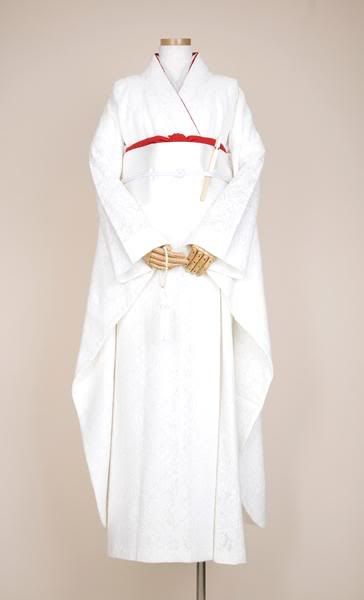 |
| Burial kimono for a woman from IG. |
 |
| Burial kimono for a man from IG. |
Tomesode is the mort formal wear for a married woman. There are two kinds of tomesode, the kurotomesode (black tomesode) and the irotomesode (colored tomesode). Black is always more formal than the colored. The kurotomesode always have five family crests and should only be worn by married woman. Irotomesode always has atleast one mon in the centre back and can be worn by unmarried ladies as well, if they feel that they have grown out of the furisode. The pattern in tomesode runs in the hem of the clothing and while being dressed, never rises higher than the hips. The pattern runs over the seams, which is a sign of a formal kimono. How high the pattenr rises depends on the age of the wearer, the high rising patterns are considered more youthful.
| Kurotomesode by my.opera. |
 |
| Irotomesode by nippon. |
Furisode is the formal kimono for an unmarried woman. The name of this kimono comes from the long, swinging sleeves of the kimono. The pattern of a furisode covers all of the kimono and it can be very brightly colored. The most decorated obi knots are also considered for the furisode ensemble. Nowadays also the obijime and obiage can be tied in very decorative styles. Furisode can be divided into three sub-categories depending on the lenght of the sleeve: Kofurisode (small swinging sleeve), Chufurisode (middle lenght swinging sleeve) and the Honfurisode (the true furisode with full lenght sleeves). As the girls school edjucation started the school uniform for girls was a kofurisode patterned in the yabane (arrow pattern) style with a hakama worn over it. Even today the style is used in graduation ceremonies.
 |
| Furisode by fashion.3yen |
 |
| Furisode by The Book of Kimono |
Houmongi or kimono for visiting. As a formal kimono it is acceptable to wear it for a wedding of a friend or a distant relative. It is said that the houmongi is the simplified version of the tomesode and the furisode. Patterning of a houmongi is rather free, but is usually consist of a decending pattern in the hem and on the sleeve/shoulder. The pattern size can be large or small. Houmongi can have mons. The pattern in a houmongi runs over the seams without breaking. The lining material in a houmongi can differ from the kimono fabric. The sleeve lenght can vary between 55cm-70cm.
 |
| Houmongi by fashion.3yen |
| Houmongi by japanmade |
Tsukesage kimono is quite like the houmongi by means on pattern, but it is considered to be less formal. The difference between houmongi and tsukesage is sometimes so small, that they can be nearly inseparable. Nowadays a hybrid of houmongi-tsukesage combines the two kimono types into a multi-use kimono. How to tell them apart then? Unlike the houmongi, a traditional tsukesage is dyed before the kimono is constructed, meaning that the pattern stops/has a hiccup when it goes over the seams.
| Tsukesage by yamatoku |
 |
| Tsukesage from IG |
Iromuji is a kimono without a pattern, but it can have a woven pattern and mons. Iromuji is never solid white or solid black. Bright, vivid colors are considered youthful and fitting for a younger woman and the broken tones and darker shades are more suitable for an older lady.
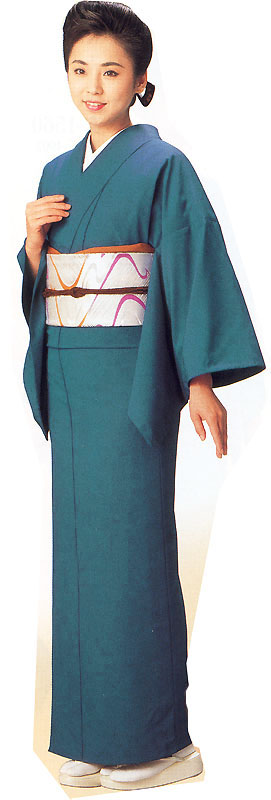 |
| Iromuji by shop-japan |
 |
| Iromuji by sweetstore-nihon |
Komon is an all patterned kimono on which the size of the pattern can diverse between almost solid color to almost plate sized. In most komon kimono the pattern run differently between the sides of the kimono, meaning that on the other size run upside down when compared to the other side. There is a hybrid, tsukesage komon, on which the pattern runs the same on the whole kimono. The small patterned komon is called Edokomon and the pattern is so small that it looks solid colored until you inspect it on close range. Ebakomon is a very rare kimono type in which the striped run horizontally.
| Komon from plumandblossom |
 |
| Komon from IG Wiki |
Yukata is a cotton kimono used after a bath or at a summer festival. Liza Dalby writes in her book Kimono - Fashioning Culture, that the japanese do not consider yukata to be a kimono, but a bathrobe, because of the lightweight cotton used to make it. Many vintage yukatas are white-indigo blue patterned. This type of blue is considered the symbol of lasting things, because the dye stayed in the cloth long without fading.
 |
| yukata from jlifeinternational |
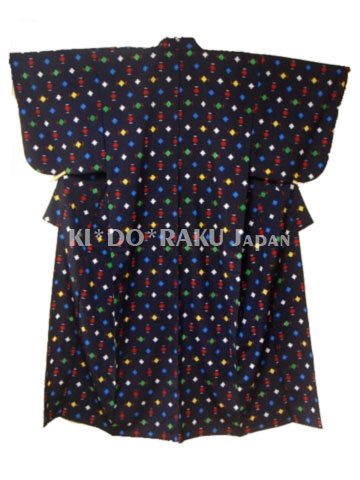 |
| Wool kimono from Kidoraku Japan |
The Book of Kimono by Norio Yamanaka
Kimono - Fashioning Culture by Liza Dalby
ImmortalGeisha Forums
ImmortalGeisha Wiki
Tunnisteet:
fabrics,
furisode,
historical dressing,
houmongi,
iromuji,
japanese,
kakeshita,
kimono,
komon,
mofuku,
shinishouzoku,
shiromuku,
tomesode,
tsukesage,
types of kimono,
uchikake,
wool kimono,
yukata
Tilaa:
Blogitekstit (Atom)















